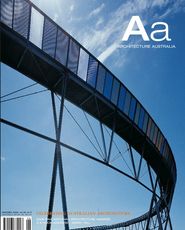UTZON’S LEGACY
Naomi Stead’s article on the legacy of Jørn Utzon brought back memories. (Architecture Australia vol 95 no 4, July/Aug 2006)
As a graduate architect working in Sydney, I marched in the “Bring Utzon Back” demonstration of February 1966.
When compared with the passion and violence of the anti-Vietnam War demonstrations which came a few years later, this was a very passive affair – more like a procession.
Architects and students, we gathered together at the southern end of the Opera House, which then consisted of dramatic, hollow shells on a massive concrete podium. A few people addressed the crowd.
There were about a hundred of us. Peter Johnson and Harry Seidler were there and, I think, Professor Ashworth from Sydney University. Ron Gilling was the NSW Chapter President. The sun was shining and it was either late morning or lunchtime.
Carrying placards and posters, we walked up the Macquarie Street footpath, on the Botanic Gardens side. Sydney office workers must have wondered what we were doing.
There were a few shouts of “Bring Utzon Back!” but no organized chanting of slogans aimed at the NSW Government.
Nor was there a repetitive chant of:
Who do we want?
UT-ZON!
When do we want him?
NOW! IAN BARWICK, RAIA
ACKNOWLEDGING WOMEN
Paul Walker’s review of Chisholm Institute’s new Dandenong campus building (Architecture Australia vol 95 no 3, May/June 2006) can be discussed in terms of its content and assessment of the building. However, the review also raises finer and more important discussions.
Journals become future records of history; therefore it is important that details are factually stated.
The existing campus building referred to by Dr Walker was by Edmond and Corrigan, not Corrigan alone. Maggie Edmond plays a pivotal and equal role in the work of Edmond and Corrigan. It seems that it is a common theme to omit the names of women when referring to architectural practices. Venturi, Scott Brown is referred to as Venturi; the names of Carme Pinós and Benedetta Tagliabue tend to be left out in discussions of their work with Enric Miralles, as does Caroline Bos’s name in her work with Ben van Berkel, to give a few examples.
Women have played an informative and productive role in the architectural profession. It is important that they be acknowledged for their contributions.
Most women suffer enough discrimination in a male-dominated industry without us writing them out of history. GIOVANNI MERCURI
THE PERILS OF THE GOLD COAST
Does anyone else feel uneasy about Architecture Australia extolling the virtues of two new Gold Coast high-rise residential towers? (Architecture Australia vol 95 no 4, July/Aug 2006.)
I’ve always considered the Gold Coast a monument to the greed and corruption of Joh Bjelke-Petersen’s Queensland. The attendant white-shoe brigade of sleazy property developers made millions out of the massive overdevelopment and consequent degradation of those once-beautiful foreshores. It seems that nothing has changed.
Not only is the Gold Coast nowadays an incredibly ugly and tacky place, but it is also an environmental disaster waiting to happen. Apart from the significant damage already caused to the beaches and the surrounding landscape, there is the prospect of it being totally wiped out in the short term by the odd freak wave (not to mention a tsunami). In the long term, it is at risk from destruction by rising sea levels caused by global warming. Its built environment is a lesson in what not to do.
One of the towers featured in Architecture Australia is the 80-storey Q1 apartment tower, which is by far the tallest building in the place, ranking up there with the towers of Shanghai and Dubai as a fine example of the crassness of excess.
Could it next feature in AA as one of the Queensland Chapter’s civic design award winners? TONY COOTE, RAIAEditor’s note:Architecture Australia reviewed two projects on the Gold Coast, which provide useful opportunities to consider how architects might engage with this difficult urban environment – Air, by Ian Moore Architects, and Innovarchi’s work which concerned only the podium and ground plane of Q1, not the tower itself.
CRITICAL REVIEW
Over the years one tends to become accustomed, even immune, to the poetic hyperbole and reels of superlatives when confronted with Leon van Schaik’s “reviews” in your magazine. However, his latest, “St Andrews Beach House” designed by Sean Godsell takes the cake. Yes, God is really doing his best to Sell! (Architecture Australia vol 95 no 5, Sept/Oct, 2006).
A nice steel box, elevated above the sand dunes, is flowered upon with an ingenious array of phrases and words – Spaceship, Telescope, Fish, Zen, Spray-on-Skin, and so on, ad infinitum. Substantial parts of Mr van Schaik’s review espouse the architect’s own opinions. Where is the critical component?
Is this a “critical review” or just a profuse and gushing banner of praise?
This leads to a more serious concern that relates directly to the role and responsibility of Architecture Australia to encourage and publish bona-fide critical appraisals of illustrated works. For decades AA has been (particularly when compared to serious European architectural publications) nothing more than a slick coffee-table journal, presenting many full-page coloured photos, architects’ own statements of their buildings and conciliatory reviews by various academics, with seldom even a grain of indepth criticism.
Surely it is time to present to your readers in Australia and overseas with a platform for critical debate relating to published works of Australian architecture, and thereby initiate an ongoing culture of criticism, which so far has been sadly lacking. BORIS KAZANSKI, AKNW, FRAIA.
KAZANSKI KEILHACKER URBAN DESIGN ARCHITEKTUR, BERLIN.Editor’s note: We welcome constructive criticism, however, a number of points should be clarified. Architecture Australia does not publish architects’ statements, nor does it show reviews to architects prior to publication. Writers are expected to express their own opinion of the project under review. All reviews are independently commissioned peer reviews by writers, academics and practitioners of note with relevant expertise.
LESLIE WILKINSON
Recently, members of the RAIA were sent the very informative Gold Medal publication. There is, however, one glaring error. Our first Gold Medallist, Professor Leslie Wilkinson (1882–1972), would not look kindly on being described as a “Spanish mission” architect. He would probably turn in his grave. CLIVE LUCAS, FRAIAEditor’s note: The Gold Medal publication was produced by staff at the RAIA’s national office and distributed as a Special Edition of the RAIA’s national magazine Architecture Australia. Regular issues of Architecture Australia are produced by the editorial team at Architecture Media.















